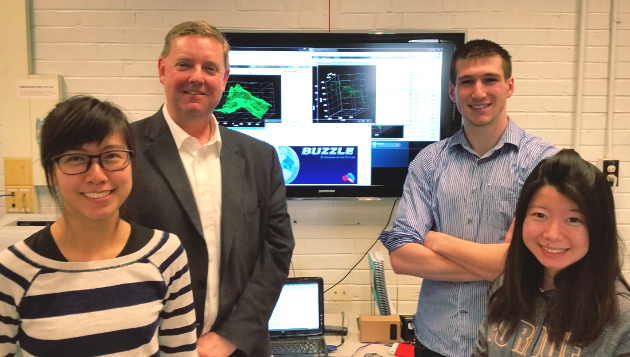ILNumerics® supports Research in Aviation
3D Object Detection - A huge Challenge

Detecting 3D objects in a landscape point cloud was the challenge that undergraduate students Steven Pugia, Keryse Deng, and Joelle Chia from Purdue University faced. Together with their academic supervisor Professor Timothy Ropp from the Hangar of the Future Research Laboratory at Purdue they participated in a Case Competition sponsored by The Boeing Company intended to find the next generation of IT leaders. Leveraging the power of the ILNumerics library they stood up to the challenge.

The team: Prof. Ropp, Steven Pugia, Keryse Deng and Joelle Chia
Cutting-Edge Technology for Real World Problems
The Hangar of the Future Research Laboratory is a multi-disciplinary, collaborative research space within the Aviation Department of Purdue University. Students experience practical research, rapid and innovative solution development and testing of some far out, novel uses of existing technologies. “Our mission is to use technology to advance air transportation process Safety, Quality and Reliability outcomes in a rapidly evolving sensor-embedded industry” says Timothy Ropp, professor for Aeronautical Engineering Technology and lead faculty at Hangar of the Future. Ropp routinely consults with industry leaders about the latest challenges. “I like to bring these experiences directly back to the classroom, challenging students to leverage their learning, seeking unique solutions to real world problems using cutting edge practices and technologies. And this competition is one example.”
Computing and Visualization for Big Data
This competition is about detecting 3D objects in a landscape. Smart systems of the future will be able to detect and classify objects automatically. “Take an airplane for example. Wouldn’t it be great if it was able to detect another airplane as well as the landing strip and – more importantly – tell the difference between the two?” says Steven Pugia the lead developer of the student team at Hangar of the Future. “The challenge is that there is so much data and we needed to find a smart and efficient way to identify objects against a landscape.” The students were given a data file with 5,000,000 points in x,y and z coordinates. The data needs to be searched and matched with five objects that the committee gave the students. Searching this much data a powerful and robust visualization and computing engine was needed. And this is where ILNumerics comes in.
The challenge: finding a cone, a cylinder and a sphere in the landscape
Focus on Performance and Reliability
ILNumerics is a C# library for scientific computing and visualization. Exploiting the managed language it is capable of very efficient data manipulation, mathematical processing and visualization. “Our development team spent a great effort to make sure that all of our algorithms are reliable and efficient.” says Haymo Kutschbach, CEO of ILNumerics. “Apart from that we focused on performance. We are proud that we’re the most efficient, robust and comprehensive scientific library out there.” And the student team benefit from that.
Simple and Convenient
The coding of the application was done in C# with large parts utilizing the ILNumerics library. It offers a comprehensive list of mathematical functions and visualization options. “It was really easy” says Steven. “The functions worked out of the box and I was able to concentrate on the algorithm. ILNumerics did all the rest in the background.” Professor Ropp adds “ILNumerics really combines efficiency with convenience.”
Application Screenshots
